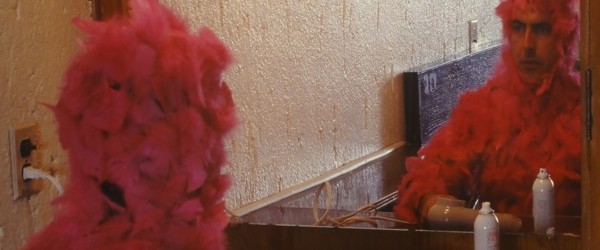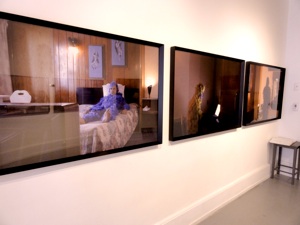
Inside Gary Varro’s ‘Chicken Inn’
Art, Art NewsIn Gary Varro’s Chicken Inn the setting is just as important as the subject matter. The snapshots were sparked from within a dingy motel room, which is said to be part of the last “No-Tell-Motel” in Regina, Saskatchewan.
Pivoting between discovery and ridicule, the feathered chicken acts as a unit of routine placed in a confining space – viewers see this ‘chicken’ tippy-toe between escapism and its return to habitual self-extensions.
“I wanted to create a kind of narrative of suffering, oppression, downfall, self-loathing and insanity countered with elements that would contrast and create some kind of irony and humour,” explains Varro.
The ‘chicken’ exists and thrives through Gary’s own permeable direction where props and gestures help conjure a thematic catalogue of photographs, ones that soak with quirky resin.
The mundane exercises humans so often perform are part of Varro’s visual dialogue, and so to—an expressionless ‘chicken’ seen maneuvering within altering scenarios. It’s a series that appeals to the wandering eye type, but one that also understands cinematic preciseness.
“What is interesting is that I think we normally tend to ‘perform’ or put on a persona when we are out in public, whether we are aware of it or not. But there really is a safety in this that does not exist in ones private setting. In the public realm this safety net (self-consciousness, propriety, and the law) catches you from taking your clothes off, masturbating, defecating, singing out loud, crying, farting, although many of us have actually done some of these things and witnessed these things, often presuming/concluding that the person is mentally challenged or just very uninhibited,“ Varro furthers.
Varro draws this sense of outward creativity and design from his work in film.
“I look at the series as an installation as well as documentation of a place, and to some extent performative – partly because of the feathered/chicken guise and partly because of the location being a motel room. I work in the film industry as a production designer and art director, and when I think about it now, the motel room was very much like a set or location for a film shoot. I looked high and low for a motel that had enough atmospheres that would help to embellish the desired look and feel of the different scenarios.”
A key takeaway is to see the parallels between the subject and the discourse.
“On one hand you have this dumpy/seedy motel room, a character on its own. Even though it has seen better days, it is still great to look at. On the other hand, and even though the expressionless chicken person is doing unremarkably inane things, the chicken person is adorned in multiple colors of feathers – flamboyant, ridiculous, silly, funny.”
Understanding the scenario divides and the fact of not understanding is something Varro has always been drawn to.
“Transgressive art is of special interest to me, I think being a queer artist and curator includes admiring artists who make work that is not always easily understood or demands a kind of difficult – but ultimately fantastic – process of reading and thinking. I also admire work that is poetic, quiet, spare, bare, and at its heart is about things that are heart-felt private ideas and expressions.”
Chicken Inn came to be out of a two-day photo shoot in Regina, Saskatchewan. Varro rented two motel rooms and jetted between each, being tarred and feathered, soaked with paint, running practically naked in -50 wind chill weather. The two motel rooms were not beside each other. Varro’s body and head also had to be completely shaved. This process was done over and over until twelve photos were captured, exposing the detail and circumstance that Varro desired.
Learn about Queer City Cinema [www.queercitycinema.ca/2012/], of which Gary has been a curator and artistic director for since 1996.
Chicken Inn was on exhibition during the month of September 2012 at gallerywest, 1172 Queen St. W. [Toronto].























